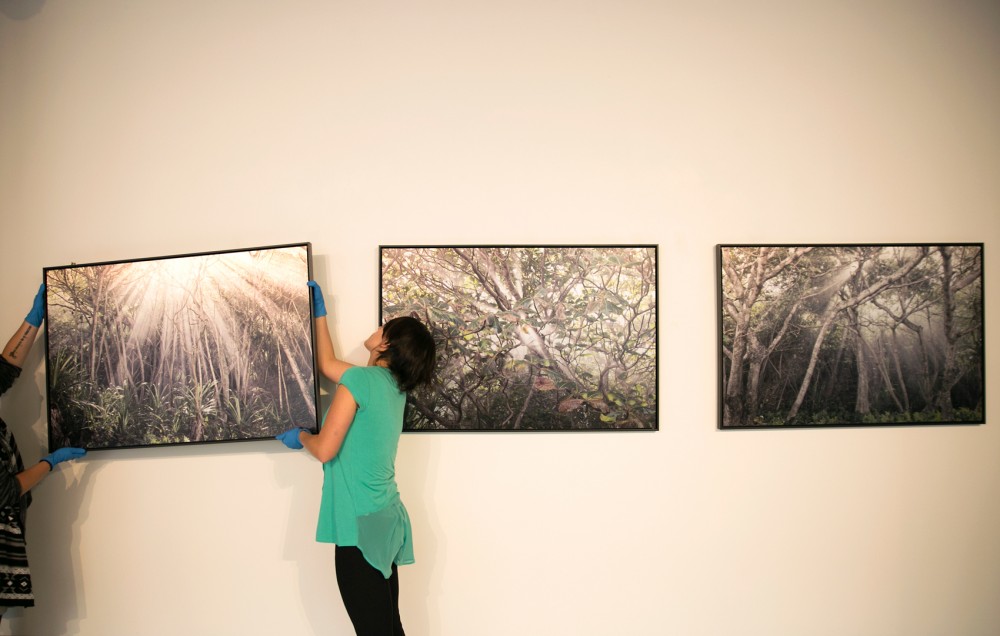Natural light spills through the tall windows of the Quarter Gallery and a photo of a forest comes to life. It’s as if the light bursting through the trees is not a captured reflection of old light, instead beaming from some sun behind the manicured, white wall.
This is the effect of Ann Ginsburgh Hofkin’s aluminum prints. Assistant curator Térez Iacovino’s says it’s her favorite aspect of the soon-to-open “Reflections” exhibition housed at the Regis Center for Art.
“There’s this iridescence and quality of retaining light with [the aluminum printing process] that I feel even further enhances the images,” Iacovino said.
Hofkin is a local, self-trained photographer. Her photos are characteristically dramatic and often otherworldly. The collection is a combination of color and black-and-white
prints. The color photos are taken digitally and printed on aluminum.
“The metal prints are exciting because it’s almost like a third dimension,” Hofkin said. “I find it very magical to stand here in this lighting and it almost takes on a 3-D quality.”
However, it’s the black-and-white photos that are Hofkin’s signature style. Hofkin shoots with infrared film, which captures visible light as well as the infrared spectrum.
Infrared is normally invisible to the human eye and adds depth to the photos.
“Using a material that can demonstrate the existence of things that you wouldn’t know about otherwise is very thrilling to me,” Hofkin said. “It’s like uncovering a treasure …
On the film, the silver highlights collect and become dense. You have an exaggeration, which turns out to be very dramatic and very mysterious.”
The 120mm infrared film Hofkin uses was discontinued nearly 10 years ago. At that time, Hofkin purchased almost 500 rolls, which she stores in her freezer. Because there are only 10 shots to a roll, she uses them sparingly.
When capturing a subject, Hofkin said the light is the deciding factor in regards to which process to use.
“The quality of light for infrared is pretty specific for me,” Hofkin said. “It’s more of a directional light. Since I’ve done this for almost 40 years, [the light] dictates to me what kind of material to use. I’m not one of those people who wants to carry around 40 lenses and just be bothered with, ‘Well what should I use for this?’ I want the camera to be an extension of my eye and my heart.”
The exhibition title, “Reflections” has a dual meaning. On one hand, each image is literally a reflection, but Hofkin hopes they will also challenge the viewer to reflect on the natural world.
“One thing photography has done for me is it has made me much more aware of what is around us,” Hofkin said. “I think we have to work hard to take care of our blessings and our gifts.”
Hofkin is particularly concerned with natural resources and their ongoing availability.
“Making people aware of what we have and what we need is really important,” Hofkin said. “I could feel uplifted by the beauty of a tree, but also it’s essential to our well-being.
And we have to appreciate it. I want to make people aware of some of these things and the fact that we’re not all-powerful, but we all have something we can do — and should do.”
The doors to the exhibition will officially open today, but the public reception will coincide with the “Covered in Time and History: The Films of Ana Mendieta” exhibition on Sept. 19. Hofkin is part of the A.I.R. Gallery in New York, the same gallery that represented Mendieta.
“We thought it would be a beautiful, serendipitous event to have two women from the same gallery showing at the same time,” Iachovino said. “It’s two exhibitions for one journey.”








